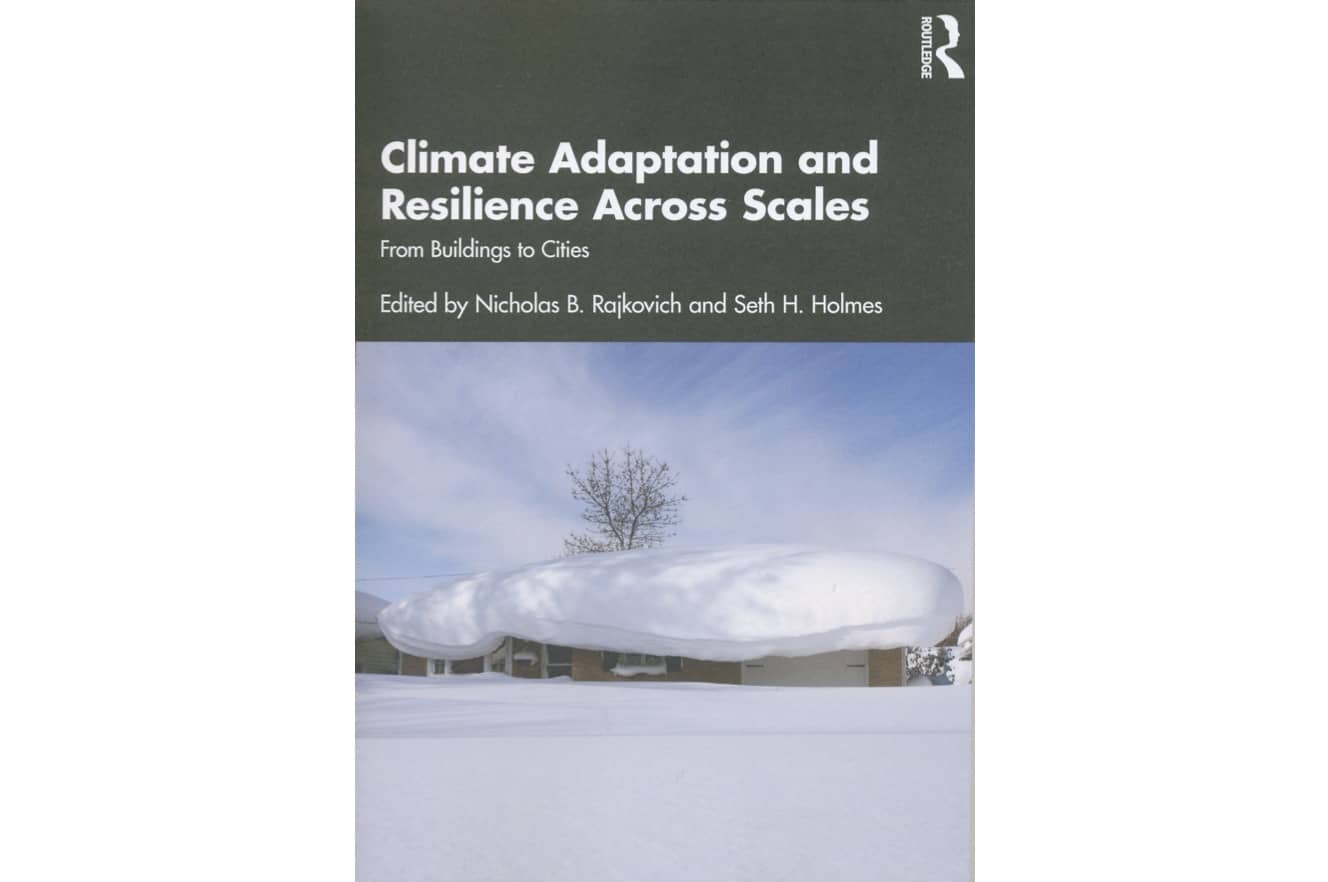
www.buildingsandcities.org/insights/reviews/climate-adaptation-and-resilience.html
Climate Adaptation and Resilience Across Scales From Buildings to Cities

Edited by N.B. Rajkovich and S.H. Holmes. Routledge, 2022. ISBN 9780367467333
Richard Graves (University of Minnesota) reviews this book (with open access availability) providing guidance and examples for improving the climate resilience cities and buildings.
Climate change presents not only an existential threat to humanity as outlined in the latest reports by the International Panel on Climate Change (2021), but also a new reality for professionals to integrate into all projects. Efforts to mitigate climate change and reduce the impacts are essential, but the process is not moving fast enough to avoid significant impacts. Accepting the consequences of a changing climate and designing for adaptation is not surrender, but an urgent reality to design for adaptation. This timely book provides a range of perspectives on the critical design issues for climate change.
In the Foreword, Ann Kosmal outlines the collection of interdisciplinary approaches gathered in the book. It should be a call to action for not just design teams, but leaders of all types: community, policy makers, developers and beyond. Readers of the book will find themselves responding not only in their professional roles, but also as citizens of their community and as individuals. A key concern is: what knowledge and insights can help build your capacity to respond to the challenge? Building capacity can occur at a range of scales from individual mindset to facilitation of stakeholder processes to researching climate modeling. The answers are delivered in a range of forms from new methods, strategies, project case studies, tools and expanded perspectives. While many of the answers may not be the ultimate solutions, they begin to lay out the ingredients of an effective design method for adapting to climate change. As Holmes and Rajkovich outline in the Introduction:
this book is not a prescriptive approach of one discipline, the chapters that follow consider climate adaptation and resilience through the lenses of architecture, landscape architecture, planning and engineering.
A core question of designing for a climate adaptation and resilience at all scales is: "what is the new climate that a design should consider?" The Intergovernmental Panel on Climate Change (2021) has released its Sixth Assessment Report. This models potential scenarios for the effects of climate change at the global and regional scale. Temperature, precipitation, biodiversity, agriculture and other factors are considered. However, design practitioners and researchers must understand and translate this information to the scale of the built environment: buildings, neighborhoods, cities, watersheds etc. In addition, the global data need to be downscaled and expanded to consider not only temperature and rainfall, but also wind speed, humidity and other factors that inform the design of built environment. The book does not consider the most current climate predictions but starts a conversation on the research methodology to apply to any set of climate prediction data to translate it to building design. Chapter 2 by Seth Holmes provides an excellent survey of building simulations that have used climate change simulations. In addition, the chapter reviews design measures that could mitigate the impacts of the changing climate and a process for evaluating results. It establishes a knowledge foundation for anyone interested in exploring the dynamic and critically needed research in translating planetary scale climate models into useful tools for design simulation. The other chapters in the simulation sector of the book seek to explore the use of alternative methods and tools to bridge the complex world of climate simulation into longer term building design, community engagement and even individuals with the decision-making tools for a broad audience.
Kristin Baja's chapter on the concept of Resilience Hubs is a powerful exploration of the concept and process that communities can use to building their resilience capacity. The intention is to not just create a building that is used temporarily, but a center that helps a community thrive. Resilience hubs do this by fostering connectivity and focusing on the development of five foundation areas: services and programming, buildings and landscape, power systems, communications and operations. The concept has the potential to not only meet community needs at a variety of scales, but also be a catalytic tool for community resilience.
The chapters on climate change and health (Connecting the Dots, Building a Resilient Future and Increasing Adaptive Capacity of Vulnerable Populations) propose a shift in the design process to 'co-create' a vision for a resilient future with all members of the community. The most disadvantaged members of society are often the most adversely affected by climate change. Climate justice involves four interconnected dimensions (Klinsky and Mavrogianni, 2020): there are disparities in the causal responsibility, impacts, vulnerability and social, temporal and spatial distance from climate change. Policy makers, strategists and designers should not only be aware of the inequitable effects of climate change and the missing perspectives, but also the need for an inclusive resilient design process. The book calls for a longer view of community infrastructure that considers them outlasting climate impacts. It may be impossible for buildings to 'outlast' climate impacts, but the goal of shifting the focus from responding to immediate challenges to a longer and potentially multi-scaled approach to time should benefit the resilient design process. Maisel, Perez and Macy's chapter on engaging stakeholders in climate resilience to increase a community's adaptive capacity is a powerful call for equity in the resilient design process. An inclusive process could benefit resilient design on many levels from integrating community capacity building to understanding local knowledge and perspectives to increasing empathy, connection and communication. This chapter presents one of the more powerful calls to action for designers and communities to get to work on building community resilience and share their stories. However, the chapters do not go far enough in reconsidering the role of the designer/planner in an inclusive planning process. At a minimum, further discussion of the planner as bricoleur: orchestrating the co-creation process with stakeholders and building their capacity to develop transformative solutions should be explored in the future of the work.
Alex Wilson's chapter on Passive Survivability re-connects with his thoughtful body of work over 15 years. This began with the New Orleans Principles (US Green Building Council 2005) to outline a method that enables buildings to provide a habitable environment after disruptions (hurricanes, floods, social unrest etc.) of the provision of electricity, water and other essential services. Simple in concept, the chapter explores new methods, metrics and modeling to assess a buildings ability to provide 'passive survivability'. Wilson advocates additional research is undertaken to define the concept with more specific requirements. In the future, a passive survivability requirement could be integrated into building codes as an important life safety measure.
The book concludes with case studies of resilient design in a variety of contexts and scales with a final chapter with interviews from practitioners. The perspectives are from a variety of sectors, disciplines and regions of North America. This conversation provides a starting point for applying resilient design in practice. It conveys the successes, barriers, frustration and drive to integrate resilient design across many scales to benefit communities in a dynamic future. Such conversations represent an important trajectory forward for putting the theory of resilient design into practice. In the future, this work could be extended to a wider set of community design practitioners to not only include professionals, but also the experience and insights of community members to share their stories of the power of design to build a resilient future.
This book deserves to be widely read internationally. Although its focus is primarily on a North American perspective of resilience, its goal is to kickstart interdisciplinary dialogue, deeper understandings and collective action to anticipate and create a resilient built environment. It urges us to initiate a long-term process of adaptation to climate change. Expanded dialogue will also help to integrate a more international conversation and call for action. This will enable designers, planners, policy makers, developers and community members to create, adapt and maintain a built environment that responds to climate change. Such actions will protect the vulnerable, but also provide well-being for all.
References
Klinsky, S. & Mavrogianni, A. (2020). Climate justice and the built environment. Buildings and Cities, 1(1), 412-428. DOI: http://doi.org/10.5334/bc.65
International Panel on Climate Change. (2021). Climate Change 2021: The Physical Science Basis. Contribution of Working Group I to the Sixth Assessment Report of the Intergovernmental Panel on Climate Change [Masson-Delmotte, V., P. Zhai, A. Pirani, S.L. Connors, C. Péan, S. Berger, N. Caud, Y. Chen, L. Goldfarb, M.I. Gomis, M. Huang, K. Leitzell, E. Lonnoy, J.B.R. Matthews, T.K. Maycock, T. Waterfield, O. Yelekçi, R. Yu, and B. Zhou (eds.)]. Cambridge University Press.
US Green Building Council (2005). The New Orleans Principles: Celebrating the Rich History of New Orleans Through Commitment to a Sustainable Future. New Orleans Planning Charrette after Hurricane Katrina.
Latest Peer-Reviewed Journal Content
A framework for 1.5°C-aligned GHG budgets in architecture
G Betti, I Spaar, D Bachmann, A Jerosch-Herold, E Kühner, R Yang, K Avhad & S Sinning
Net zero retrofit of the building stock [editorial]
D Godoy-Shimizu & P Steadman
Co-learning in living labs: nurturing civic agency and resilience
A Belfield
The importance of multi-roles and code-switching in living labs
H Noller & A Tarik
Researchers’ shifting roles in living labs for knowledge co-production
C-C Dobre & G Faldi
Increasing civic resilience in urban living labs: city authorities’ roles
E Alatalo, M Laine & M Kyrönviita
Co-curation as civic practice in community engagement
Z Li, M Sunikka-Blank, R Purohit & F Samuel
Preserving buildings: emission reductions from circular economy strategies in Austria
N Alaux, V Kulmer, J Vogel & A Passer
Urban living labs: relationality between institutions and local circularity
P Palo, M Adelfio, J Lundin & E Brandão
Living labs: epistemic modelling, temporariness and land value
J Clossick, T Khonsari & U Steven
Co-creating interventions to prevent mosquito-borne disease transmission in hospitals
O Sloan Wood, E Lupenza, D M Agnello, J B Knudsen, M Msellem, K L Schiøler & F Saleh
Circularity at the neighbourhood scale: co-creative living lab lessons
J Honsa, A Versele, T Van de Kerckhove & C Piccardo
Positive energy districts and energy communities: how living labs create value
E Malakhatka, O Shafqat, A Sandoff & L Thuvander
Built environment governance and professionalism: the end of laissez-faire (again)
S Foxell
Co-creating justice in housing energy transitions through energy living labs
D Ricci, C Leiwakabessy, S van Wieringen, P de Koning & T Konstantinou
HVAC characterisation of existing Canadian buildings for decarbonisation retrofit identification
J Adebisi & J J McArthur
Simulation and the building performance gap [editorial]
M Donn
Developing criteria for effective building-sector commitments in nationally determined contributions
P Graham, K McFarlane & M Taheri
Reimagining circularity: actions for optimising the use of existing buildings
R Lundgren, R Kyrö, S Toivonen & L Tähtinen
Effective interdisciplinary stakeholder engagement in net zero building design
S Vakeva-Baird, F Tahmasebi, JJ Williams & D Mumovic
Metrics for building component disassembly potential: a practical framework
H Järvelä, A Lehto, T Pirilä & M Kuittinen
The unfitness of dwellings: why spatial and conceptual boundaries matter
E Nisonen, D Milián Bernal & S Pelsmakers
Environmental variables and air quality: implications for planning and public health
H Itzhak-Ben-Shalom, T Saroglou, V Multanen, A Vanunu, A Karnieli, D Katoshevski, N Davidovitch & I A Meir
Exploring diverse drivers behind hybrid heating solutions
S Kilpeläinen, S Pelsmakers, R Castaño-Rosa & M-S Miettinen
Urban rooms and the expanded ecology of urban living labs
E Akbil & C Butterworth
Living with extreme heat: perceptions and experiences
L King & C Demski
A systemic decision-making model for energy retrofits
C Schünemann, M Dshemuchadse & S Scherbaum
Modelling site-specific outdoor temperature for buildings in urban environments
K Cebrat, J Narożny, M Baborska-Narożny & M Smektała
Understanding shading through home-use experience, measurement and modelling
M Baborska-Narożny, K Bandurski, & M Grudzińska
Building performance simulation for sensemaking in architectural pedagogy
M Bohm
Beyond the building: governance challenges in social housing retrofit
H Charles
Heat stress in social housing districts: tree cover–built form interaction
C Lopez-Ordoñez, E Garcia-Nevado, H Coch & M Morganti
An observational analysis of shade-related pedestrian activity
M Levenson, D Pearlmutter & O Aleksandrowicz
Learning to sail a building: a people-first approach to retrofit
B Bordass, R Pender, K Steele & A Graham
Market transformations: gas conversion as a blueprint for net zero retrofit
A Gillich
Resistance against zero-emission neighbourhood infrastructuring: key lessons from Norway
T Berker & R Woods
Megatrends and weak signals shaping future real estate
S Toivonen
A strategic niche management framework to scale deep energy retrofits
T H King & M Jemtrud
Generative AI: reconfiguring supervision and doctoral research
P Boyd & D Harding
Exploring interactions between shading and view using visual difference prediction
S Wasilewski & M Andersen
How urban green infrastructure contributes to carbon neutrality [briefing note]
R Hautamäki, L Kulmala, M Ariluoma & L Järvi
Implementing and operating net zero buildings in South Africa
R Terblanche, C May & J Steward
Quantifying inter-dwelling air exchanges during fan pressurisation tests
D Glew, F Thomas, D Miles-Shenton & J Parker
Western Asian and Northern African residential building stocks: archetype analysis
S Akin, A Eghbali, C Nwagwu & E Hertwich
Join Our Community

The most important part of any journal is our people – readers, authors, reviewers, editorial board members and editors. You are cordially invited to join our community by joining our mailing list. We send out occasional emails about the journal – calls for papers, special issues, events and more.
We will not share your email with third parties. Read more



Latest Commentaries
COP30 Report
Matti Kuittinen (Aalto University) reflects on his experience of attending the 2025 UN Conference of the Parties in Belém, Brazil. The roadmaps and commitments failed to deliver the objectives of the 2025 Paris Agreement. However, 2 countries - Japan and Senegal - announced they are creating roadmaps to decarbonise their buildings. An international group of government ministers put housing on the agenda - specifying the need for reduced carbon and energy use along with affordability, quality and climate resilience.
Building-Related Research: New Context, New Challenges
Raymond J. Cole (University of British Columbia) reflects on the key challenges raised in the 34 commissioned essays for Buildings & Cities 5th anniversary. Not only are key research issues identified, but the consequences of changing contexts for conducting research and tailoring its influence on society are highlighted as key areas of action.